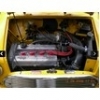Update:
I've changed old metal fuel pipes to new flexible fuel pipes with metal braiding. (I read somwehere that Vapour locking is not unusual in old cars run on modern unleaded wiyth metal fuel pipes in engine compartment).
Whilst changing them, noticed that there was very free flow of petrol (under gravity) from tank to pump.
Old pipes were perished but still patent, no visible debris in them.
Not really surprising then that new pipes made NO difference - same problem of rough runnig as it warms up, tending to stall and no chance of restarting when hot.
The new pipes look good though, and I'm sure are less likely to leak / split in future than the old rubber connectors between metal pipes.
by the way, after some hours struggling to get new feed into pump, decided to remove crancase breather cannister from rear of engine block (it's only 1 13mm bolt) - much better access for my neanderthal hands.
Whilst poking around with air filter off, checked out float valve as suggested by midridge2.
All very clean, no debris, plastic float intact (no leak), needle valve moving very freely, float pivot allowing free mvt of float. I checked it when hot as well, in case of heat-dependent binding: no seizing of valve or pivot.
One thing: the manual suggests there should b 3.18-4.76mm celarance between lowest part of float (held upsiade down off-car and allowed to sit under gravity against tip of needle valve) and inside of lid of float chamber. My gap seems more like 8mm, with no visible way of adjusting. The float is of the type with NO metal arm to bend, so the only way of adjusting float height is by changing depth of washers in the needle seating. Can't believe this is the cause, as the float chamber is 3/4 full of petrol, whether I open it cold or hot (i.e. when stalled). I could fidle around with washers in seating of needle valve, except I can't remove the pivot pin. I think it is just a tap-out job, isn't it? But it won't bude, and I don't want to hit it too hard and risk doing damage to the float / bending the pivot pin (both seem to be working fine).
So today when it was warmed up, I turned it off (after completing above checks) and tried restarting it. Very reluctant again, but it did start. - sounds like an old slow revving thuddy wide bore m/c engine when it fires initially, before firing up and allowing throttle use up to normal revs. It ran a bit rough for a while. I revved it (at approx the same revs levels as i would driving on teh road) for 1 min. It was still running a bit rough but didn't stall if i tickled the throttle. After turning off, it would not start again.
Whilst it was still hot, checked to see if good spark at HT lead end (where it connects to distributor cap) - great steady string spark, so I suspect coil is OK.
Checked for sparks at plug gaps - VERY DUBIOUS: weak spark, or not at all. Sometimes spark seemd to flop down sides of central insulator rather than jump gap. All plugs much the same. All plugs noted to be carbonised - i.e. dry carbon, no oil fouling and specifically no petrol smell - no hint of flooding.
I've checked all connections to distributor / coil / points (all are new). Checked cap and rotor arm - both new and look pristine, no tracking. Checked points gap - right where it should be (0.35mm), which is reassuring as I recently set it with dwell meter (51 degs) and haven't touched it since.
So, I fear we have at 2 problems, which is why it is proving so frustrating:
1) despite careful checking of ignition system before posting on here, there seems to be a heat-sensitive fault somewhere between HT lead from coil 9which is sparking reliably) and plugs. I find it hard to believe ALL HT leads to plugs have given up the ghost suddenly, and I can't see any shorting sparks when I examine HT leads carefully running the car in the dark. However, I will invest in new HT leads if I have to. Do you think dodgy HT leads to plugs would explain teh heat-sensitive ignition problem?
2) fuel delivery still an issue. I like te explanation of Mini Mad about relative fuel starvation when hot, except: plugs indicate running too rich , when it runs at all (carbonised rather than light grey). Also, when it is running (even if a bit rough) at normal temp, doing the piston-lifting-pin method of assessing fuel mix suggests exactly the right mix (revs rise slightly before falling back on lifting piston). However, I'm game for a challenge, so will open the fuel mix screw richer and try again.
I'll report back after starter spray / HT lead changes / fuel enrichment, but I'm on the point of giving up and asking my local friendly mechanic if he fancies taking it on. I hate giving up!
by the way, did anyone see my commet about wheezing?
By the way, did anyone see my comment about the wheezing noise:
"When the engine speed starts to die before it stalls (or I tap the accelerator to keep it alive, or pull the choke a bit out), there is an odd noise from the engine. The closest I can describe it is like a quiet asthmatic wheeze, but continuous. It seems to come from the alternator end of things, but I could be wrong. It goes away if I can pursuade the engine speed back up to normal idle. Mean anything to anyone?"
Perhaps my mini is so old it has developed bronchitis?
Thanks again to all.















